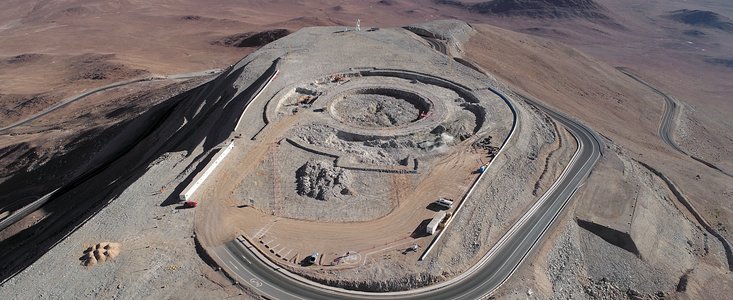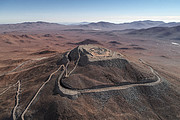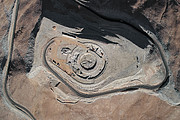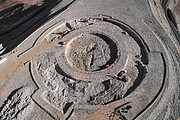Annuncio
Iniziati i lavori per le fondamenta dell’ELT sul Cerro Armazones
07 Maggio 2018
Sul Cerro Armazones, a un’altitudine di oltre 3000 metri nel Deserto di Atacama in Cile, sono iniziati gli scavi per le fondamenta della cupola e della struttura del telescopio ELT (Extremely Large Telescope) dell’ESO. I lavori sono condotti dal Consorzio ACe, formato da Astaldi e Cimolai. Queste fantastiche foto sono state scattate per immortalare l’evento da Gerhard Hüdepohl, ambasciatore fotografo dell’ESO, che ha usato un drone per guardare il Cerro Armazones dall’alto.
Abbreviato in ELT, questo nuovo e rivoluzionario telescopio da terra avrà uno specchio primario da 39 metri e sarà il più grande telescopio al mondo nell'ottico e vicino infrarosso: "il più grande occhio del mondo rivolto al cielo". La costruzione dovrebbe essere completata in tempo per la prima luce, prevista per il 2024.
Lavorare a grandi altitudini non è semplice, ma ne varrà davvero la pena; il sito è alto, secco e privo di inquinamento luminoso. Fornirà dunque eccellenti condizioni di seeing, in modo da permettere agli astronomi di investigare sui misteri del cosmo come non è mai stato fatto prima d’ora.
Nella foto è ben visibile il contorno della struttura principale del telescopio, il quale, una volta completato, sarà coperto da una cupola alta 80 metri. Al centro, la fossa circolare da 55 metri di diametro conterrà le fondamenta delle strutture che sosterranno il gigantesco specchio primario da 39 metri, che dà il nome all’ELT. La foto mostra anche in modo chiaro quanto sarà grande il telescopio; i vari macchinari di costruzione intorno sembrano minuscoli rispetto alle imponenti fondamenta dell’ELT, mentre le persone presenti nel sito sono quasi invisibili.
Il Cerro Armazones dista soli 22 chilometri dall’attuale osservatorio principale dell’ESO, il VLT (Very Large Telescope), tanto che ogni sito è visibile dall’altro, mentre la distanza in auto tra i due è di circa 30 minuti. Ciò permetterà all’ELT di essere vicino alle infrastrutture e agli edifici di supporto attualmente utilizzati per il VLT. In realtà il Cerro Armazones era stato quasi scelto come sito per il VLT, ma poi fu preferito il Cerro Paranal. Tuttavia, grazie agli attuali lavori, anche il Cerro Armazones avrà presto il suo telescopio.
Contatti
Richard Hook
ESO Public Information Officer
Garching bei München, Germany
Tel: +49 89 3200 6655
Cell: +49 151 1537 3591
Email: rhook@eso.org
A proposito dell'annuncio
| Identificazione: | ann18031 |
Our use of Cookies
We use cookies that are essential for accessing our websites and using our services. We also use cookies to analyse, measure and improve our websites’ performance, to enable content sharing via social media and to display media content hosted on third-party platforms.
ESO Cookies Policy
The European Organisation for Astronomical Research in the Southern Hemisphere (ESO) is the pre-eminent intergovernmental science and technology organisation in astronomy. It carries out an ambitious programme focused on the design, construction and operation of powerful ground-based observing facilities for astronomy.
This Cookies Policy is intended to provide clarity by outlining the cookies used on the ESO public websites, their functions, the options you have for controlling them, and the ways you can contact us for additional details.
What are cookies?
Cookies are small pieces of data stored on your device by websites you visit. They serve various purposes, such as remembering login credentials and preferences and enhance your browsing experience.
Categories of cookies we use
Essential cookies (always active): These cookies are strictly necessary for the proper functioning of our website. Without these cookies, the website cannot operate correctly, and certain services, such as logging in or accessing secure areas, may not be available; because they are essential for the website’s operation, they cannot be disabled.
Functional Cookies: These cookies enhance your browsing experience by enabling additional features and personalization, such as remembering your preferences and settings. While not strictly necessary for the website to function, they improve usability and convenience; these cookies are only placed if you provide your consent.
Analytics cookies: These cookies collect information about how visitors interact with our website, such as which pages are visited most often and how users navigate the site. This data helps us improve website performance, optimize content, and enhance the user experience; these cookies are only placed if you provide your consent. We use the following analytics cookies.
Matomo Cookies:
This website uses Matomo (formerly Piwik), an open source software which enables the statistical analysis of website visits. Matomo uses cookies (text files) which are saved on your computer and which allow us to analyze how you use our website. The website user information generated by the cookies will only be saved on the servers of our IT Department. We use this information to analyze www.eso.org visits and to prepare reports on website activities. These data will not be disclosed to third parties.
On behalf of ESO, Matomo will use this information for the purpose of evaluating your use of the website, compiling reports on website activity and providing other services relating to website activity and internet usage.
Matomo cookies settings:
Additional Third-party cookies on ESO websites: some of our pages display content from external providers, e.g. YouTube.
Such third-party services are outside of ESO control and may, at any time, change their terms of service, use of cookies, etc.
YouTube: Some videos on the ESO website are embedded from ESO’s official YouTube channel. We have enabled YouTube’s privacy-enhanced mode, meaning that no cookies are set unless the user actively clicks on the video to play it. Additionally, in this mode, YouTube does not store any personally identifiable cookie data for embedded video playbacks. For more details, please refer to YouTube’s embedding videos information page.
Cookies can also be classified based on the following elements.
Regarding the domain, there are:
- First-party cookies, set by the website you are currently visiting. They are stored by the same domain that you are browsing and are used to enhance your experience on that site;
- Third-party cookies, set by a domain other than the one you are currently visiting.
As for their duration, cookies can be:
- Browser-session cookies, which are deleted when the user closes the browser;
- Stored cookies, which stay on the user's device for a predetermined period of time.
How to manage cookies
Cookie settings: You can modify your cookie choices for the ESO webpages at any time by clicking on the link Cookie settings at the bottom of any page.
In your browser: If you wish to delete cookies or instruct your browser to delete or block cookies by default, please visit the help pages of your browser:
Please be aware that if you delete or decline cookies, certain functionalities of our website may be not be available and your browsing experience may be affected.
You can set most browsers to prevent any cookies being placed on your device, but you may then have to manually adjust some preferences every time you visit a site/page. And some services and functionalities may not work properly at all (e.g. profile logging-in, shop check out).
Updates to the ESO Cookies Policy
The ESO Cookies Policy may be subject to future updates, which will be made available on this page.
Additional information
For any queries related to cookies, please contact: pdprATesoDOTorg.
As ESO public webpages are managed by our Department of Communication, your questions will be dealt with the support of the said Department.




